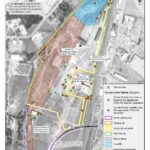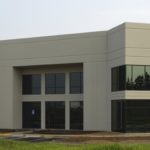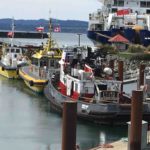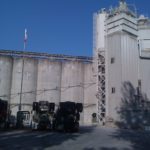Wave Point Consulting’s logistics real estate case studies demonstrate how we help assess market opportunities and reduce risks for infrastructure projects.
Logistics Real Estate Development
City of Cranbrook Industrial Lands Study (2020)
 The City of Cranbrook awarded the Wave Point Consulting led consulting team an initiative to provide an assessment and analysis relating to brownfield/industrial land development. This project provided the City with an overview of the economic value of the former 99-acre Tembec property (Cranbrook Industrial Lands) as a part of an economic development strategy to maximize the return on investment and benefits to the community. The primary deliverables were related to providing:
The City of Cranbrook awarded the Wave Point Consulting led consulting team an initiative to provide an assessment and analysis relating to brownfield/industrial land development. This project provided the City with an overview of the economic value of the former 99-acre Tembec property (Cranbrook Industrial Lands) as a part of an economic development strategy to maximize the return on investment and benefits to the community. The primary deliverables were related to providing:
- Market Development and Servicing Review,
- Land Disposal and Economic Analysis.
- Land Development Strategy Recommendations.
The work created a strategic base and framework for economic development initiatives by the City of Cranbrook.
Lloydminster Transload (2020)

The City of Lloydminster engaged the Davies Transportation Consulting Inc. (DTCI) led team to assess the economic feasibility and potential options for construction of a transload facility at one of three sites identified by the City. The assessment process involves two phases: Phase 1 to assess the economic feasibility of a transload facility; if the assessment is positive, a Business Plan will be developed in Phase 2. Mr. Anderson was a senior consultant on the project team.
Industrial Land Intensification Study (2019)
 The purpose of this study is to explore the effective use of a municipality’s industrial lands. Potential conflicts arise from the need to accommodate increased economic activity on a limited land base while maintaining the City’s long-term industrial capacity. Rapid advances in technology and changing workforce requirements will also shape the future of the City’s industrial lands. The impact of changes in technology is already evident in changes in physical distribution networks. For example, e-commerce delivery systems are transforming retail and logistics for consumer goods, resulting in the development of larger and larger distribution centres with a higher ceiling, stacking/racking equipment, and sustainable designs to reduce energy consumption and waste.
The purpose of this study is to explore the effective use of a municipality’s industrial lands. Potential conflicts arise from the need to accommodate increased economic activity on a limited land base while maintaining the City’s long-term industrial capacity. Rapid advances in technology and changing workforce requirements will also shape the future of the City’s industrial lands. The impact of changes in technology is already evident in changes in physical distribution networks. For example, e-commerce delivery systems are transforming retail and logistics for consumer goods, resulting in the development of larger and larger distribution centres with a higher ceiling, stacking/racking equipment, and sustainable designs to reduce energy consumption and waste.
The Wave Point multi-disciplinary team is using a proven mix of qualitative and quantitative methods supported by the complementary subject matter expertise of team members to complete the project. In addition to the use of existing literature and secondary data sources, primary research through representative stakeholder consultations will be done using a mix of stakeholder sessions and in-person meetings Our approach is guided by a philosophy of being as practical and as pragmatic as possible with our work methods and research outcomes.
Logistics Facility Hub (2018)
 The logistic real estate project was completed for the City of Cranbrook by Davies Transportation Consulting Inc. as prime contractor, in association with Wave Point Consulting Ltd, Hooper Engineering, and Licker Geospatial Consulting Co. The City engaged the team to conduct a study on the feasibility of developing a transportation/logistics park and intermodal hub within the City. The development concept included potential logistics and transportation facilities as well as ancillary services such as storage, warehousing and trucking industry services. The development area was defined as any underutilized railway lands, City owned lands, or industrial property that could be made rail accessible within the City. The report provided market intelligence in the most promising short-term and longer-term advice regarding the availability of rail transportation is a strategic asset for attracting new supply chain logistics investment in heavy industry requiring carload rail service or rail transload operations, and the availability of industrial land with rail access.
The logistic real estate project was completed for the City of Cranbrook by Davies Transportation Consulting Inc. as prime contractor, in association with Wave Point Consulting Ltd, Hooper Engineering, and Licker Geospatial Consulting Co. The City engaged the team to conduct a study on the feasibility of developing a transportation/logistics park and intermodal hub within the City. The development concept included potential logistics and transportation facilities as well as ancillary services such as storage, warehousing and trucking industry services. The development area was defined as any underutilized railway lands, City owned lands, or industrial property that could be made rail accessible within the City. The report provided market intelligence in the most promising short-term and longer-term advice regarding the availability of rail transportation is a strategic asset for attracting new supply chain logistics investment in heavy industry requiring carload rail service or rail transload operations, and the availability of industrial land with rail access.
Port Kells Industrial Lands (2018)
 Site Economics Ltd. was retained to provide an independent assessment of industrial land supply and demand and estimate the economic, employment, and taxation impacts of, the logistic real estate project proposed for the Port Kells area of Surrey BC. Darryl Anderson and Phil Davies were retained to be part of the project team led by Site Economics to assist with the analysis of the transportation infrastructure, industrial real estate market and industrial land supply and demand update. Project involvement also included helping with the creation of the financial model to evaluate the development concept and economic impacts.
Site Economics Ltd. was retained to provide an independent assessment of industrial land supply and demand and estimate the economic, employment, and taxation impacts of, the logistic real estate project proposed for the Port Kells area of Surrey BC. Darryl Anderson and Phil Davies were retained to be part of the project team led by Site Economics to assist with the analysis of the transportation infrastructure, industrial real estate market and industrial land supply and demand update. Project involvement also included helping with the creation of the financial model to evaluate the development concept and economic impacts.
International Trade Enabling Logistics Park Screening Level Business Plan (2016)
 A confidential logistics real estate development client retained Wave Point Consulting to investigate potential land uses for a large parcel of land, strategically located in proximity to a Class 1 rail line, a paved highway and a container terminal on the West Coast of North America. The scope of work included a high-level forecast of port goods movement, an assessment of current market conditions for facilities to support international trade, a screening of potential opportunities for a stand-alone logistics operation, or the integration of the property with existing and future port projects. Logistics infrastructure consultants also identified and evaluated commercial risks and partnerships opportunities for the client in light of their interests and objectives for employment and economic development and sustainability.
A confidential logistics real estate development client retained Wave Point Consulting to investigate potential land uses for a large parcel of land, strategically located in proximity to a Class 1 rail line, a paved highway and a container terminal on the West Coast of North America. The scope of work included a high-level forecast of port goods movement, an assessment of current market conditions for facilities to support international trade, a screening of potential opportunities for a stand-alone logistics operation, or the integration of the property with existing and future port projects. Logistics infrastructure consultants also identified and evaluated commercial risks and partnerships opportunities for the client in light of their interests and objectives for employment and economic development and sustainability.
Container Logistics Industrial Land Requirements, Industrial Land Intensification Best Practices, and Industrial Land Expansion (2015-2016)
 Wave Point Consulting Ltd. was retained to be part of the Site Economic Ltd. led project team that was asked by a confidential client to provid an overview of the container logistics network, identify requirements of container logistics and distribution facility developers, operators, users and railways in terms of preferred locations within a port complex on the Pacific Coast of North America. The scope of work for the logistics real estate project included identifying the advantages and disadvantages of alternative locations beyond the port’s immediate hinterland suitable to meet the land use demand for logistics and distribution facilities in support of forecast volumes generated by new terminal development and growth from existing container terminals. The second project involved a literature review and research on logistic functional and site requirements, building and technology best practices and measurements for the intensification of industry real estate.
Wave Point Consulting Ltd. was retained to be part of the Site Economic Ltd. led project team that was asked by a confidential client to provid an overview of the container logistics network, identify requirements of container logistics and distribution facility developers, operators, users and railways in terms of preferred locations within a port complex on the Pacific Coast of North America. The scope of work for the logistics real estate project included identifying the advantages and disadvantages of alternative locations beyond the port’s immediate hinterland suitable to meet the land use demand for logistics and distribution facilities in support of forecast volumes generated by new terminal development and growth from existing container terminals. The second project involved a literature review and research on logistic functional and site requirements, building and technology best practices and measurements for the intensification of industry real estate.
Truck Stop Services in British Columbia Market Research (2015-2016)
 Philip Davies led this study. Collaborating team members were from Wave Point Consulting, S5 Services, and Site Economics. The BC provincial government wished to explore partnership opportunities and identify locations that would suit the development of comprehensive truck stop services. The scope of work for the transportaion infrastructure development consultants included describing this industry’s growth potential within BC; identify the most promising locations for private sector development and explore the pros and cons of different partnership models. The project methodology required the logistics infrastructure consultants to use of both qualitative and quantitative analysis to: define the critical service requirements, develop an industry and growth profile, assessment of current services, identification of high priority locations, business case model and development of policy options for infrastructure investment.
Philip Davies led this study. Collaborating team members were from Wave Point Consulting, S5 Services, and Site Economics. The BC provincial government wished to explore partnership opportunities and identify locations that would suit the development of comprehensive truck stop services. The scope of work for the transportaion infrastructure development consultants included describing this industry’s growth potential within BC; identify the most promising locations for private sector development and explore the pros and cons of different partnership models. The project methodology required the logistics infrastructure consultants to use of both qualitative and quantitative analysis to: define the critical service requirements, develop an industry and growth profile, assessment of current services, identification of high priority locations, business case model and development of policy options for infrastructure investment.
Industrial Land Use Evaluation and Risk Assessment (2015)
 The stated goal of the customer was to understand the risks, probabilities, and consequences of industrial land use both generally and pertaining directly to the client city. The impetus of this goal was underscored by recent events in Canada wherein the transportation of dangerous goods to and from heavy industrial uses has come under increased scrutiny due to high profile accidents involving surface transport modes. Mr. Anderson and Davies are being retained by Golder Associates to evaluate the industrial risk including an analysis of the movement of industrial or chemical goods. Transportation-related land uses and a network of rail and road configuration were completely integrated into the dynamic nature of hazardous materials. The logistics infrastructure consultants identifed and quantify industrial risks both from a land use and transportation perspective, with the ultimate goal of providing tools for evaluating industrial real estate risk.
The stated goal of the customer was to understand the risks, probabilities, and consequences of industrial land use both generally and pertaining directly to the client city. The impetus of this goal was underscored by recent events in Canada wherein the transportation of dangerous goods to and from heavy industrial uses has come under increased scrutiny due to high profile accidents involving surface transport modes. Mr. Anderson and Davies are being retained by Golder Associates to evaluate the industrial risk including an analysis of the movement of industrial or chemical goods. Transportation-related land uses and a network of rail and road configuration were completely integrated into the dynamic nature of hazardous materials. The logistics infrastructure consultants identifed and quantify industrial risks both from a land use and transportation perspective, with the ultimate goal of providing tools for evaluating industrial real estate risk.
Ogden Point Terminal Functional Facilities Plan (2014)
 Mr. Anderson was retained by a Stantec led project for the Greater Victoria Harbour Authority (GVHA. As a senior consultant, he reviewed and confirmed previous market condition assumptions and identified gaps or needs to be considered as part of the functional and facilities planning process. The focus of the work was on deepening the client’s understanding of the cruise passenger and marine cargo market conditions that would influence the development of the Ogden Point Master Plan. Major issues related to industrial real estate land use and spatial planning infrastructure development were identified so the implications of these factors could be considered in a proactive manner. The Functional and Facilities Plan focused on the strategic development of Ogden Point, determining what infrastrcture investment is viable in the near and long term for the site, and how it will impact or benefit the GVHA and stakeholders.
Mr. Anderson was retained by a Stantec led project for the Greater Victoria Harbour Authority (GVHA. As a senior consultant, he reviewed and confirmed previous market condition assumptions and identified gaps or needs to be considered as part of the functional and facilities planning process. The focus of the work was on deepening the client’s understanding of the cruise passenger and marine cargo market conditions that would influence the development of the Ogden Point Master Plan. Major issues related to industrial real estate land use and spatial planning infrastructure development were identified so the implications of these factors could be considered in a proactive manner. The Functional and Facilities Plan focused on the strategic development of Ogden Point, determining what infrastrcture investment is viable in the near and long term for the site, and how it will impact or benefit the GVHA and stakeholders.
Distribution Center Business Development Strategy (2013)
 A confidential private sector client engaged the Wave Point Consulting team to prepare a business development strategy to increase the market share of a logistics real estate facility located on the west coast of North America. The important supply chain facility was in a geographic location with good surface transportation access and proximity to international shipping services and marine terminal facilities. Changes in the marketplace presented new opportunities to leverage the use of existing assets to contribute to short-term revenue growth, secure longer-term operational efficiency and increase market share for the logistics and transportation infrastructure asset. The logistics infrastructure consultants prepared a conceptual land use plan for a multimodal logistics park infrastructure development project.
A confidential private sector client engaged the Wave Point Consulting team to prepare a business development strategy to increase the market share of a logistics real estate facility located on the west coast of North America. The important supply chain facility was in a geographic location with good surface transportation access and proximity to international shipping services and marine terminal facilities. Changes in the marketplace presented new opportunities to leverage the use of existing assets to contribute to short-term revenue growth, secure longer-term operational efficiency and increase market share for the logistics and transportation infrastructure asset. The logistics infrastructure consultants prepared a conceptual land use plan for a multimodal logistics park infrastructure development project.
Maritime Terminal Regulatory Strategy (2012)
 Business Issue: the Wave Point Consulting team was retained by a confidential client to conduct a high-level regulatory strategy for an energy-related maritime terminal facility located within the jurisdiction of a Port Authority on the West Coast of North America. The infrastructure development regulatory strategy considered the permits, licenses and approvals (PLAs) needed for a project environmental assessment and those regulations pertinent to any land/water tenures, and other resources. The results were used to identify, define and reduce the investment risks during the planning phase of the project and thereby enable the firm to reduce the time to market for a mid-market energy producer.
Business Issue: the Wave Point Consulting team was retained by a confidential client to conduct a high-level regulatory strategy for an energy-related maritime terminal facility located within the jurisdiction of a Port Authority on the West Coast of North America. The infrastructure development regulatory strategy considered the permits, licenses and approvals (PLAs) needed for a project environmental assessment and those regulations pertinent to any land/water tenures, and other resources. The results were used to identify, define and reduce the investment risks during the planning phase of the project and thereby enable the firm to reduce the time to market for a mid-market energy producer.
Major Industrial Database Project Alberta Industrial Heartland Association (2009)
 Mr. Darryl Anderson of Wave Point Consulting was a principal researcher, survey designer, client interviews and database designer for industrial real estate project led by Phil Davies. Business Issue: the project focused on energy sector business retention, expansion, and new investment attraction. The purpose of the project was to develop a “major industrial database” on industries in the Alberta’s Industrial Heartland region and Strathcona Industrial Association region. Client value-added: Development of the database will facilitate marketing of the region to potential investors, and enable Alberta’s Industrial Heartland to identify opportunities for the creation of a globally competitive cluster of value-added petrochemical production. The results of the analysis were used by the organization to gauge their progress attracting new investment and their market share of current industrial development.
Mr. Darryl Anderson of Wave Point Consulting was a principal researcher, survey designer, client interviews and database designer for industrial real estate project led by Phil Davies. Business Issue: the project focused on energy sector business retention, expansion, and new investment attraction. The purpose of the project was to develop a “major industrial database” on industries in the Alberta’s Industrial Heartland region and Strathcona Industrial Association region. Client value-added: Development of the database will facilitate marketing of the region to potential investors, and enable Alberta’s Industrial Heartland to identify opportunities for the creation of a globally competitive cluster of value-added petrochemical production. The results of the analysis were used by the organization to gauge their progress attracting new investment and their market share of current industrial development.
Canadian Rockies International Airport (2018)
 A Development Plan for Commercial Lands was completed in 2010. The City of Cranbrook and Cranbrook Rockies International Airport (CRIA) wish to develop an updated logistics real estate strategy for attracting commercial development on airport industrial real esate lands based on current market opportunities and competitive strengths of the airport. Phil Davies led a team including Darryl Anderson to complete an analysis of the commercial development opportunities related to core activities at CRIA including the aviation and aerospace sectors. The project scope included the following: (a) Reviewing and forecast of regional air traffic trends and air cargo markets; (b) Analysis of the BC aerospace sector, and consultation and interviews with industrial and commercial businesses in the aviation and aerospace sector to identify potential market opportunities for development of aviation-related facilities on the Cranbrook Airport lands; (c) Analysis of other potential commercial opportunities for industrial real estate development at the airport; and (d) An assessment of real estate factors affecting the competitiveness of airport property relative to other locations.
A Development Plan for Commercial Lands was completed in 2010. The City of Cranbrook and Cranbrook Rockies International Airport (CRIA) wish to develop an updated logistics real estate strategy for attracting commercial development on airport industrial real esate lands based on current market opportunities and competitive strengths of the airport. Phil Davies led a team including Darryl Anderson to complete an analysis of the commercial development opportunities related to core activities at CRIA including the aviation and aerospace sectors. The project scope included the following: (a) Reviewing and forecast of regional air traffic trends and air cargo markets; (b) Analysis of the BC aerospace sector, and consultation and interviews with industrial and commercial businesses in the aviation and aerospace sector to identify potential market opportunities for development of aviation-related facilities on the Cranbrook Airport lands; (c) Analysis of other potential commercial opportunities for industrial real estate development at the airport; and (d) An assessment of real estate factors affecting the competitiveness of airport property relative to other locations.
Regional Airport Economic Impact Assessment (2012)
 Business Issue: the Regional District of Kootenay Boundary engaged our firm to undertake a study to evaluate the full economic impact of the Trail Regional Airport facility/services within the Greater Tail geographic area. The study’s results are a key tool for communicating the important role this efficient transportation infrastructure asset is to the region. The study assists airport stakeholders in the evaluation of strategic market issues in economic terms, so commercial and policy solutions improve the effectiveness of air access to the community and help foster economic growth for the surrounding area and reduce the risk of future airport investments. The study captured the full scope of the Trail Regional Airport’s impacts, including, but not limited to, logistics and the supply chain that is dependent on this transportation means. A clear business picture and outlook paved the way for change in ownership to the City of Trail and planning for additional investments in airport buildings to support growth.
Business Issue: the Regional District of Kootenay Boundary engaged our firm to undertake a study to evaluate the full economic impact of the Trail Regional Airport facility/services within the Greater Tail geographic area. The study’s results are a key tool for communicating the important role this efficient transportation infrastructure asset is to the region. The study assists airport stakeholders in the evaluation of strategic market issues in economic terms, so commercial and policy solutions improve the effectiveness of air access to the community and help foster economic growth for the surrounding area and reduce the risk of future airport investments. The study captured the full scope of the Trail Regional Airport’s impacts, including, but not limited to, logistics and the supply chain that is dependent on this transportation means. A clear business picture and outlook paved the way for change in ownership to the City of Trail and planning for additional investments in airport buildings to support growth.
Air Traffic & Airport Improvement Strategy (2011)
 Mr. Darryl Anderson was the project manager for the Omineca Beetle Action Coalition report concerned with increasing growth and aligning future transportation infrastructure development investments with customer needs. Philip Davies provided expert advice on regional economic and aviation trends and aviation activity for this project, and Roy Matson of RMAT Consulting provided airport-planning expertise. The Omineca Beetle Action Committee (OBAC) OBAC was formed in 2005 to develop a diversification plan and implement strategies to reduce the economic impacts of the mountain pine beetle infestation on local communities. Business Issue: the objective of the Air Traffic and Airport Improvement Project was to develop a strategy to enhance performance to enable the OBAC region to attract investment, capitalize on existing business opportunities, and reduce infrastructure investment decisions risk by preparing for long-term growth aligned with regional aviation activity trends and needs. The scope of the project included aviation market research, functional analysis of operational, infrastructure and land use issues. Client value-added: The resulting strategy included recommendations from the logistics infrastructure consultants or airport operations and improvement at the regional and local levels.
Mr. Darryl Anderson was the project manager for the Omineca Beetle Action Coalition report concerned with increasing growth and aligning future transportation infrastructure development investments with customer needs. Philip Davies provided expert advice on regional economic and aviation trends and aviation activity for this project, and Roy Matson of RMAT Consulting provided airport-planning expertise. The Omineca Beetle Action Committee (OBAC) OBAC was formed in 2005 to develop a diversification plan and implement strategies to reduce the economic impacts of the mountain pine beetle infestation on local communities. Business Issue: the objective of the Air Traffic and Airport Improvement Project was to develop a strategy to enhance performance to enable the OBAC region to attract investment, capitalize on existing business opportunities, and reduce infrastructure investment decisions risk by preparing for long-term growth aligned with regional aviation activity trends and needs. The scope of the project included aviation market research, functional analysis of operational, infrastructure and land use issues. Client value-added: The resulting strategy included recommendations from the logistics infrastructure consultants or airport operations and improvement at the regional and local levels.
Airport Industrial Real Estate Marketing Study (2011)
 Mr. Darryl Anderson was the project manager and Phil Davies a senior consultant for a logistics real estate study that examined the factors that drive aviation stakeholder location and business development decisions, focusing on general aviation interests and the market potential for Vanderhoof airport. Business Issue: the Wave Point Consulting led study reviewed the current state of the general aviation sector, identified key factors influencing aviation related business opportunities and identified the typical land use and infrastructure required for such businesses. Project tasks included sample selection, in-person and executive telephone interviews, data analysis and the development of client recommendations. Interview instruments captured qualitative and quantitative data for assessing the factors affecting a representative group of current and potential customers (Air Charter, Aircraft Maintenance, Aircraft Owners/Operators, Avionic Sales/Services, Corporate Aviation, Emergency Response/Fire Fighting, Institutional/Flight Training, Aviation Related) decision-making criteria for providing service to, or using a specific port. The results of the study were used to guide the further airport land development and the marketing efforts of the Vanderhoof airport. The industrial real estate consultants provided advice on the creation of a land use site plan and the management of planning and development issues related to the agricultural land reserve and the subdivision of property. The outcome was new private sector investment in airside infrastructure and buildings for the initial creation of an aviation-related industrial park and the reintroduction of the airshow.
Mr. Darryl Anderson was the project manager and Phil Davies a senior consultant for a logistics real estate study that examined the factors that drive aviation stakeholder location and business development decisions, focusing on general aviation interests and the market potential for Vanderhoof airport. Business Issue: the Wave Point Consulting led study reviewed the current state of the general aviation sector, identified key factors influencing aviation related business opportunities and identified the typical land use and infrastructure required for such businesses. Project tasks included sample selection, in-person and executive telephone interviews, data analysis and the development of client recommendations. Interview instruments captured qualitative and quantitative data for assessing the factors affecting a representative group of current and potential customers (Air Charter, Aircraft Maintenance, Aircraft Owners/Operators, Avionic Sales/Services, Corporate Aviation, Emergency Response/Fire Fighting, Institutional/Flight Training, Aviation Related) decision-making criteria for providing service to, or using a specific port. The results of the study were used to guide the further airport land development and the marketing efforts of the Vanderhoof airport. The industrial real estate consultants provided advice on the creation of a land use site plan and the management of planning and development issues related to the agricultural land reserve and the subdivision of property. The outcome was new private sector investment in airside infrastructure and buildings for the initial creation of an aviation-related industrial park and the reintroduction of the airshow.
Real Estate Analysis
Overarching Strategy & National Accommodation Strategy for Health Canada (2009/10 & 2013)
 Mr. Darryl Anderson, Managing Director Wave Point Consulting, was the director and team leader for three real estate analysis projects. The overall objective was for Wave Point Consulting to develop and present an overarching cohesive real property strategy for Health Canada’s Facilities & Securities Directorate and a subsequent decision to provide real property support to the Public Health Agency of Canada. The work involved reviewing all existing initiatives and issues then summarizing and presenting the actions and tactics, so they were clearly aligned with and support Health Canada’s corporate objectives. Wave Point Consulting Ltd. also led a team that assessed the anticipated demand and supply characteristics of commercial office space required by the client over a 5-year period. The project resulted in executive level approval of a commercial office strategy for approximately 11,000 employees was received. The National Accommodations Strategy (NAS), was a national master strategy for planning, acquisition, life-cycle management, and maintenance for a real estate portfolio in Ottawa and across the country. The NAS has been recognized both by the federal government and by the Real Property Institute of Canada, as a “best practice” and has resulted in Health Canada reducing real estate costs by over $65 Million Dollars. The cost savings are projected to increase to approximately $100 Million as the strategy is fully implemented.
Mr. Darryl Anderson, Managing Director Wave Point Consulting, was the director and team leader for three real estate analysis projects. The overall objective was for Wave Point Consulting to develop and present an overarching cohesive real property strategy for Health Canada’s Facilities & Securities Directorate and a subsequent decision to provide real property support to the Public Health Agency of Canada. The work involved reviewing all existing initiatives and issues then summarizing and presenting the actions and tactics, so they were clearly aligned with and support Health Canada’s corporate objectives. Wave Point Consulting Ltd. also led a team that assessed the anticipated demand and supply characteristics of commercial office space required by the client over a 5-year period. The project resulted in executive level approval of a commercial office strategy for approximately 11,000 employees was received. The National Accommodations Strategy (NAS), was a national master strategy for planning, acquisition, life-cycle management, and maintenance for a real estate portfolio in Ottawa and across the country. The NAS has been recognized both by the federal government and by the Real Property Institute of Canada, as a “best practice” and has resulted in Health Canada reducing real estate costs by over $65 Million Dollars. The cost savings are projected to increase to approximately $100 Million as the strategy is fully implemented.
Commercial Property Vacancy Inventory (2012)
 Mr. Anderson completed a real estate analysis project for a Victoria BC-based non-profit organization. The scope of the work involved the identification of suitable commercial space for office use, drop-in activity, and the large-scale assembly of people for group program activity. The methodology used to develop this commercial property vacancy inventory consisted of establishing the location of the relevant geographic market and then the identification of subject properties for the client. Secondary desk research of commercial real estate firms and the Multiple Listing Service websites were also used. Desk research was also used to determine the specific City of Victoria official community plan land use designations that applied to the properties. On-site meetings with property owner’s representatives represented the balance of the assignment. The results of the analysis were used to balance improved service efficiency with cost reduction objectives.
Mr. Anderson completed a real estate analysis project for a Victoria BC-based non-profit organization. The scope of the work involved the identification of suitable commercial space for office use, drop-in activity, and the large-scale assembly of people for group program activity. The methodology used to develop this commercial property vacancy inventory consisted of establishing the location of the relevant geographic market and then the identification of subject properties for the client. Secondary desk research of commercial real estate firms and the Multiple Listing Service websites were also used. Desk research was also used to determine the specific City of Victoria official community plan land use designations that applied to the properties. On-site meetings with property owner’s representatives represented the balance of the assignment. The results of the analysis were used to balance improved service efficiency with cost reduction objectives.
Major Industrial Real Estate Property Taxation Impacts (2011)
 Philip Davies led this real estate study for the Union of British Columbia Municipalities and BC Ministry of Community, Sport and Cultural Development in cooperation with Darryl Anderson of Wave Point Consulting Ltd. and David Lane of Lane Property Advisors Inc. Mr. Darryl Anderson of Wave Point Consulting was a senior consultant who provided analytical advice about the industrial property tax base, business investment decision making, case studies analysis and the completion of the final report. Business Issue: The objective of the study was to assess the impact of municipal property taxes on business decisions such as major capital investments, renewal of existing plants, and temporary or permanent plant closures on major industries and logistics infrastructure. The study includes detailed case studies for major industrial real estate facilities defined as Class 4 properties under BC’s Assessment Act, from a sample selected to illustrate taxation impacts on industries in various stages of commodity price and product life cycles. The study also identified and analyzes the impact of other factors including other business costs relative to taxation levels. The study results can be used by policy makers to inform more fully decisions that impact investment and job creation in their communities.
Philip Davies led this real estate study for the Union of British Columbia Municipalities and BC Ministry of Community, Sport and Cultural Development in cooperation with Darryl Anderson of Wave Point Consulting Ltd. and David Lane of Lane Property Advisors Inc. Mr. Darryl Anderson of Wave Point Consulting was a senior consultant who provided analytical advice about the industrial property tax base, business investment decision making, case studies analysis and the completion of the final report. Business Issue: The objective of the study was to assess the impact of municipal property taxes on business decisions such as major capital investments, renewal of existing plants, and temporary or permanent plant closures on major industries and logistics infrastructure. The study includes detailed case studies for major industrial real estate facilities defined as Class 4 properties under BC’s Assessment Act, from a sample selected to illustrate taxation impacts on industries in various stages of commodity price and product life cycles. The study also identified and analyzes the impact of other factors including other business costs relative to taxation levels. The study results can be used by policy makers to inform more fully decisions that impact investment and job creation in their communities.
Office Inventory Vacancy Analysis (2010)
 Mr. Anderson completed a real estate analysis project for a Victoria BC-based non-profit organization. The scope of the work involved the identification of suitable commercial space for office use, drop-in activity and the large-scale assembly of people for group program activity. The methodology used to develop this commercial property vacancy inventory consisted of establishing the location of the relevant geographic market and then the identification of subject properties for the client. Secondary desk research of commercial real estate firms and the Multiple Listing Service websites were also used. Desk research was also used to determine specific City of Victoria official community plan land use designations. On-site meetings with property owner’s representatives represented the balance of the assignment. The results of the analysis were used to balance improved service efficiency with cost reduction objectives.
Mr. Anderson completed a real estate analysis project for a Victoria BC-based non-profit organization. The scope of the work involved the identification of suitable commercial space for office use, drop-in activity and the large-scale assembly of people for group program activity. The methodology used to develop this commercial property vacancy inventory consisted of establishing the location of the relevant geographic market and then the identification of subject properties for the client. Secondary desk research of commercial real estate firms and the Multiple Listing Service websites were also used. Desk research was also used to determine specific City of Victoria official community plan land use designations. On-site meetings with property owner’s representatives represented the balance of the assignment. The results of the analysis were used to balance improved service efficiency with cost reduction objectives.

